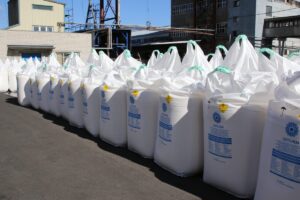
The plants of the Ostchem nitrogen holding, which unites the nitrogen businesses of Group DF, produced 849,900 tons of mineral fertilizers in January-June 2025, down 7.47% from the same period in 2024, when 918,500 tons of fertilizers were produced, according to a press release issued by the holding on Monday.
According to the report, Cherkasy Azot produced 567,100 tons of products in the first half of the year, which is 21% less than last year. Rivneazot increased production by 40.9% to 282,700 tons from 200,700 tons last year.
The overall decline in production at the holding company was explained by forced equipment shutdowns at Azot in Cherkasy in the first quarter of 2025, as well as unstable energy supplies. During this period, the holding company redistributed production loads between plants and increased fertilizer production at Rivneazot.
“Our priority remains the stable supply of fertilizers to Ukrainian farmers, even in the most difficult times. The success of spring and autumn field work depends on this. In wartime, technological flexibility, adaptability, and non-standard management decisions are paramount for us as a manufacturer. In addition, we continue to invest in production stability and energy efficiency,” said Ostchem Production Director Serhiy Pavliuchuk.
The holding company specified that the production structure has changed slightly compared to last year. In the first half of the year, ammonium nitrate was the most produced product, with 355,700 tons. Last year, this figure was 362,900 tons. UAN came in second place with a production volume of 308,900 tons. In this segment, the share of Ukrainian production remains high due to the logistical advantages of Ukrainian manufacturers. Urea came in third with 138,300 tons (183,600 tons last year). A small share of production falls on VAS – 16,200 tons and ammonia – 22,600 tons.
The release notes that against the backdrop of declining domestic production, the flow of uncontrolled cheap imports into Ukraine continues to grow: in the first half of the year, 1.5 million tons of traditional fertilizers (nitrogen and complex) were imported into Ukraine, including 828,000 tons of nitrogen fertilizers. At the same time, imports of ammonium nitrate amounted to 190,000 tons (176,600 tons last year), urea – 379,600 tons (311,300 tons), and UAN – 61,490 tons (50,800 tons).
“For the first time, the volume of urea imports has more than doubled the volume of Ukrainian production, which is an alarming signal for the entire industry and requires systemic solutions,” Ostchem concluded.
Ostchem is a nitrogen holding company owned by Dmitry Firtash’s Group DF, which brings together the largest mineral fertilizer producers in Ukraine.
Since 2011, it has included Rivneazot and Cherkasy Azot, as well as Severodonetsk Azot and Stirol, which are not operating and are located in the occupied territories.
Cherkasy Azot (Cherkasy, Ukraine) is one of Ukraine’s largest chemical companies. Its design production capacity is 962,700 tons of ammonia per year, 970,000 tons of ammonium nitrate per year, 891,600 tons of urea per year, and 1 million tons of UAN per year.
PJSC Rivneazot is one of the largest chemical companies in Western Ukraine. On April 12, 2024, Group DF and South Korea’s Hyundai Engineering signed an agreement to build a chemical hub in Rivne. The project involves the construction of plants for the production of green ammonia and hydrogen based on renewable energy sources, as well as new enterprises and production sites for the production of nitrogen fertilizers and chemical derivatives.

PJSC Azot (Cherkasy), part of the OSTCHEM nitrogen holding, has resumed production of mineral fertilizers after a forced shutdown three weeks ago due to a drop in gas pressure caused by a drone attack on Cherkasy’s external gas infrastructure, the company said in a press release on Wednesday.
“We managed to restart the plants and bring key workshops back to planned capacity after the gas infrastructure was restored. The plant is fully supplied with the gas needed for fertilizer production and continues to deliver fertilizers,” the release quotes board chairman Vitaly Sklyarov as saying.
As noted in the release, the A-3 ammonia workshop (with a capacity of 900 tons per day) and the M-2 urea workshop (1,100 tons per day) have resumed operations. Within a few days, the M-5 workshop (non-concentrated nitric acid) and the M-9 workshop (ammonium nitrate) for the production of UAN are also scheduled to be launched.
According to Sklyarov, despite the forced shutdown, the plant will fulfill its obligations in full, and the annual production plan will be met.
As reported, the plants of the OSTCHEM nitrogen holding company increased mineral fertilizer production in the first quarter of 2025 by 5.3% compared to the same period last year, to 529,300 tons: Cherkasy Azot – 394,800 tons, Rivneazot – 134,400 tons.
The release notes that OSTCHEM enterprises faced forced production stoppages due to drones entering their territory and the destruction of external gas and energy infrastructure in the Cherkasy and Rivne regions. Force majeure led to forced disruptions in fertilizer supplies.
In response, the nitrogen holding company has revised its strategy: the new priority is to reduce production risks through investments in the energy independence of enterprises.
Group DF is a diversified international group of companies consolidating assets in the gas distribution, chemical, titanium, and port industries, as well as in agriculture and media. The founder and owner of Group DF is Dmitry Firtash.
OSTCHEM is Group DF’s nitrogen holding company, which has brought together the largest producers of mineral fertilizers in Ukraine. It includes Rivneazot, Cherkasy Azot, and Severodonetsk Azot, as well as Stirol (the latter two are not operational and are located in occupied territories).
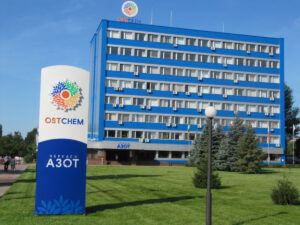
In January-March 2025, the nitrogen holding Ostchem produced 529.3 thousand tons of mineral fertilizers, which is 26.5 thousand tons, or 5.3% more than in the same period of 2023.
“The production structure changed in line with demand and imports: the share of ammonium nitrate and urea decreased, while the share of the most popular type of fertilizer, UAN (urea ammonium nitrate), increased,” the holding said in a statement on Thursday.
Ammonia nitrate production in the first quarter of 2025 decreased to 226,500 tons from 246,000 tons last year, urea to 116,700 tons from 123,500 tons, while UAN production increased from 123,800 to 162.2 thousand tons, and VAS (lime-ammonium nitrate, which is produced only at Rivneazot) – to 15.8 thousand tons from 10.8 thousand tons.
In total, Cherkasy Azot produced 394.8 thousand tons of products, and Rivneazot produced 134.4 thousand tons.
“Ostchem enterprises faced forced production stoppages due to drones entering the territory of our plants and the destruction of external gas and energy infrastructure in the Cherkasy and Rivne regions. Force majeure led to forced disruptions in fertilizer supplies, so we apologize to our customers,” the release said, citing Group DF’s head of corporate communications, Oleg Arestarkhov.
According to him, this was the most difficult season because the holding suffered huge losses due to emergency shutdowns and restarts of production facilities, but he confirmed that fertilizer orders would be fulfilled.
He also thanked the staff of the State Emergency Service of Ukraine for their help in extinguishing the fires, as well as others involved in restoring the destroyed energy and gas infrastructure.
The release also notes that the Ostchem nitrogen holding company revised its strategy in 2025: the new priority is to reduce production risks through investments in the energy independence of enterprises.
“With rising electricity prices and continuing risks, the nitrogen business is forced to take steps to ensure the stability of production chains and reduce external energy consumption,” the holding company explains.
Ostchem is Dmitry Firtash’s Group DF nitrogen holding company, which brings together the largest mineral fertilizer producers in Ukraine. Since 2011, it has included Rivneazot and Cherkasy Azot, as well as Severodonetsk Azot and Stirol, which are not operating and are located in the occupied territories.
Cherkasy Azot (Cherkasy, Ukraine) is one of Ukraine’s largest chemical companies. Its designed production capacity is 962,700 tons of ammonia per year, 970,000 tons of ammonium nitrate per year, 891,600 tons of urea per year, and 1 million tons of UAN per year.
PJSC Rivneazot is one of the largest chemical companies in Western Ukraine. On April 12, 2024, Group DF and South Korea’s Hyundai Engineering signed an agreement to build a chemical hub in Rivne. The project involves the construction of plants for the production of green ammonia and hydrogen based on renewable energy sources, as well as new enterprises and production sites for the production of nitrogen fertilizers and chemical derivatives.
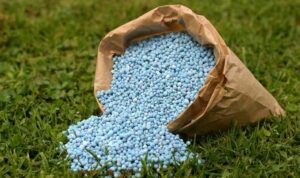
The plants of nitrogen holding Ostchem produced 1.8 million tons of mineral fertilizers in 2024, down 13% from 2023, according to a press release from Group DF International’s corporate communications department.
According to the report, Cherkasy-based Azot maintained its production level at 1.4 million tons in 2024, while Rivne Azot reduced its output by 22% and produced 407 thousand tons, down from 528 thousand tons a year earlier.
According to Group DF International, the key products produced by Ostchem’s plants were ammonium nitrate – 760.2 thousand tons (41.9% of the total), UAN – 506.7 thousand tons (27.9%), urea – 401.9 thousand tons (22.2%), and ammonia – 75 thousand tons (4.1%).
The reasons for the decline in production were low grain prices on global markets, power outages, the ongoing war and imports of cheap, low-quality fertilizers.
“Ukrainian farmers are going through difficult times, and the margins of their businesses have fallen significantly. This affects the domestic demand for mineral fertilizers – sometimes priority was given to cheaper fertilizers of dubious quality, which were imported en masse last year. We play the long game, and even in the most difficult times we ensure high international quality of our products and 100% fulfillment of our obligations. Even during the periods of forced shutdowns of Rivne Azot due to power outages, these business values remained unchanged, as Ukrainian farmers could see,” said Sergiy Pavlyuchuk, Chief Operating Officer of Ostchem’s nitrogen business.
The holding reported that in 2024, the average annual capacity utilization of Ostchem did not exceed 70%. Uncontrolled imports did not allow Ukrainian enterprises to operate at full capacity.
“Unfortunately, we were forced to cut staff and optimize costs. According to my estimates, the decline in the chemical industry was about 10%, and this is the result of growing imports and ineffective industrial policy,” Pavliuchuk said.
He added that in 2025, Ostchem has adapted to the military business environment and will continue to focus on developing new industrial sites, energy efficiency, ensuring stable operations and improving product quality in the new environment.
“The key objective for 2025 is to ensure production sustainability in the current unstable energy supply environment, reduce production risks, and replace imports with better quality. Our long-term strategic priority remains the same: import substitution and, consequently, an increase in market share. We will continue to invest in the production of the most popular fertilizers and expand our product line. First of all, we are talking about investment projects related to the launch of urea and industrial gases production,” summarized Pavliuchuk.
Ostchem is a nitrogen holding of Dmitry Firtash’s Group DF that unites the largest mineral fertilizer producers in Ukraine. Since 2011, it has included Rivne Azot and Cherkasy Azot, as well as Sievierodonetsk Azot and Stirol, which are out of operation and located in the occupied territories.
Cherkasy Azot PrJSC (Cherkasy, Ukraine) is one of the largest Ukrainian chemical enterprises. The design production capacity is 962.7 thousand tons per year of ammonia, 970 thousand tons per year of ammonium nitrate, 891.6 thousand tons of urea, and 1 million tons per year of UAN.
Rivne Azot is one of the largest Ukrainian chemical companies in Western Ukraine. On April 12, 2024, Group DF and South Korean Hyundai Engineering signed an agreement to build a chemical hub in Rivne. The project envisages the construction of green ammonia and hydrogen plants based on renewable energy sources; new enterprises and production sites for nitrogen fertilizers and chemical derivatives.
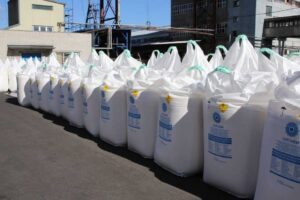
The plants of nitrogen holding Ostchem produced 1.33 million tons of mineral fertilizers in January-September 2024, down 15.3% from the same period in 2023, the holding said in a statement on Thursday.
According to the report, Cherkasy-based Azot produced 1.06 million tons of mineral fertilizers, down 13.11% year-on-year, and Rivne Azot produced 304.9 thousand tons, down 12.2%.
Production declined for all major types of nitrogen fertilizers.
Ammonium nitrate production decreased by 16.09% to 547.6 thousand tons. UAN production, which had previously shown the highest growth rate, fell by 11.68% to 417.9 thousand tons. The biggest drop in Ukrainian production was for such fertilizers as urea, down 20.17% to 263 thousand tons, and UAN, down 48.9% to 18.9 thousand tons. Production of commercial ammonia also decreased by 11.4% to 43 thousand tons.
“Today we produce as much as the market is ready to consume. Our plants were unevenly loaded in 2024 and are still not operating at full capacity. However, the hot season has now begun, and production capacity is being utilized more. Despite rising gas prices, blackouts, and increased imports from Russia-friendly countries, we are on track to meet our production targets. Ukrainian fertilizers for the agricultural sector are produced in accordance with commercial contracts, and not a single delivery has been disrupted this year,” said Sergiy Pavlyuchuk, Chief Operating Officer of Ostchem.
He added that Cherkasy Azot and Rivne Azot continue to improve the production process and implement modern energy saving solutions. In particular, the installation of an in-house power generation system helped reduce electricity consumption by 40%.
As reported, on April 12, 2024, Group DF International and South Korean Hyundai Engineering signed a large-scale agreement to build a chemical hub in Rivne. The project envisages the construction of green ammonia and hydrogen plants based on renewable energy sources; new enterprises and production sites for the production of nitrogen fertilizers and chemical derivatives.
Ostchem is a nitrogen holding of Dmitry Firtash’s Group DF, which unites the largest mineral fertilizer producers in Ukraine. Since 2011, it has included Rivne Azot and Cherkasy Azot, as well as Severodonetsk Azot and Stirol, which are out of operation and located in the occupied territories.
Cherkasy Azot PJSC (Cherkasy, Ukraine) is one of the largest Ukrainian chemical enterprises. The design production capacity is 962.7 thousand tons of ammonia per year, 970 thousand tons of ammonium nitrate per year, 891.6 thousand tons of urea, and one million tons of UAN per year.
Rivne Azot is one of the largest Ukrainian chemical companies in Western Ukraine. On April 12, 2024, Group DF and South Korean Hyundai Engineering signed an agreement to build a chemical hub in Rivne. The project envisages the construction of green ammonia and hydrogen plants based on renewable energy sources; new enterprises and production sites for nitrogen fertilizers and chemical derivatives.
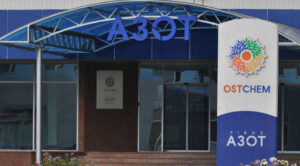
The plants of the nitrogen holding Ostchem produced 918.5 thousand tons of mineral fertilizers in the first half of 2024, which is 4.3% less than in the same period last year, the holding said in a statement on Monday.
“Uncontrolled imports cause the greatest damage to the chemical industry. Due to the dominance of cheap fertilizers from countries friendly to Russia, production volumes fell by 4.3%,” the release quoted Sergiy Pavlyuchuk, production director of Ostchem’s nitrogen business, as saying.
It also notes that the impact was caused by energy supply restrictions and a shortage of personnel.
“In addition to power outages due to the destruction of the energy infrastructure, there is also a shortage of staff: since the beginning of the full-scale war, almost 20% of employees have been mobilized at the plants, there is a staff shortage of about 15%, and we are forced to retrain staff who are learning new specialties,” Pavlyuchuk said.
According to the release, Cherkasy Azot produced 717.8 thousand tons of fertilizer in the first half of the year and remained Ukraine’s largest producer of mineral fertilizers, while Rivne Azot maintained its production at the same level as last year – 200.7 thousand tons.
High levels of dumped imports resulted in a decline in domestic production of the most popular fertilizers in Ukraine – ammonium nitrate and urea. In particular, the volume of ammonium nitrate production by Ostchem plants decreased by 9% compared to the same period last year – from 398.7 thousand tons to 362.9 thousand tons, the holding noted.
Ostchem also noted uncontrolled imports, which provoked a 10.8% decline in urea production: production fell from 205.9 thousand tons to 183.6 thousand tons.
At the same time, the holding was able to strengthen its position in the urea-ammonia mixture (UAN) market. In the first half of the year, UAN production at Ostchem’s plants increased by 11.4%, from 277.7 thousand tons to 309.2 thousand tons. The holding explains this by the high popularity of this fertilizer and the logistical advantages of Ukrainian producers. To meet the growing demand, new UAN production sites are being set up at Cherkasy Azot (capacity of 1 million tons per year) and Rivne Azot (capacity of 300 thousand tons per year).
According to the holding, the total volume of nitrogen fertilizer imports to Ukraine in 1H2024 amounted to 1.298 million tons. At the same time, imports of ammonium nitrate amounted to 176.6 thousand tons, urea – 311.3 thousand tons, NPK – 108.5 thousand tons, sulfate – 159.8 thousand tons, NP – 77.71 thousand tons, and UAN – 50.8 thousand tons.
Ostchem is the nitrogen holding of Dmitry Firtash’s Group DF, which unites the largest mineral fertilizer producers in Ukraine. Since 2011, it has included Rivne Azot and Cherkasy Azot, as well as Severodonetsk Azot and Stirol, which are out of operation and located in the occupied territories.
Cherkasy Azot PrJSC (Cherkasy, Ukraine) is one of the largest Ukrainian chemical companies. The design production capacity is 962.7 thousand tons per year of ammonia, 970 thousand tons per year of ammonium nitrate, 891.6 thousand tons of urea, and 1 million tons per year of UAN.
Rivne Azot is one of the largest Ukrainian chemical companies in Western Ukraine. On April 12, 2024, Group DF and South Korean Hyundai Engineering signed an agreement to build a chemical hub in Rivne. The project envisages the construction of green ammonia and hydrogen plants based on renewable energy sources; new enterprises and production sites for nitrogen fertilizers and chemical derivatives.